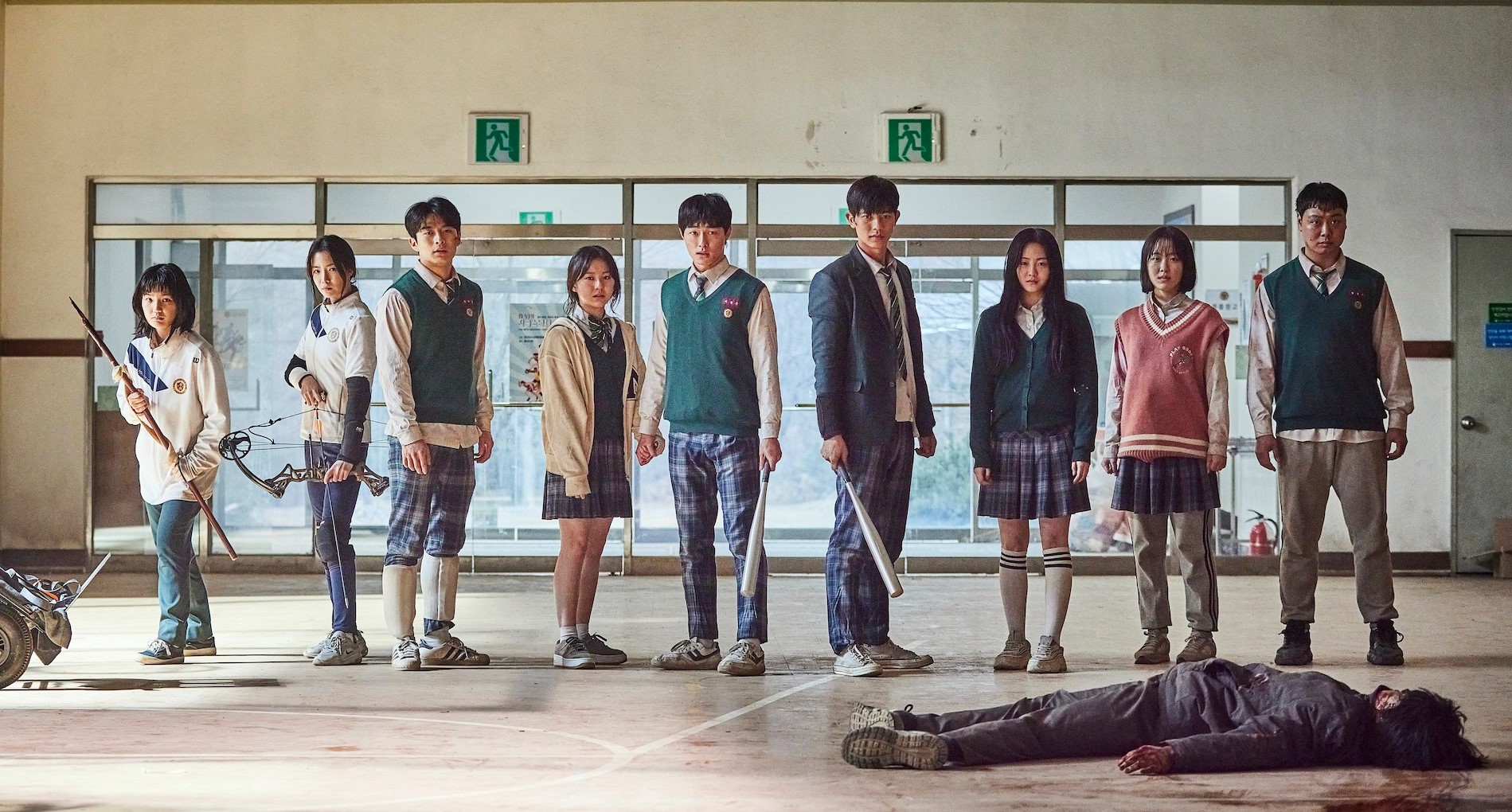Zombies. We know them very well from the dozens of series and movies out there portraying these monstrous walking dead bodies as determining the end of the world. Then why should you hear about another of these types of productions? Well, simply put, “All of Us Are Dead” is a breath of fresh air. Even though the world is saturated with zombie content, “this series is more than your average zombie outbreak trope” (Collider).
Based on the webtoon “Now at Our School”, horror thriller K-drama “All of Us Are Dead” (지금 우리 학교는) was released on 28th January 2022, and soon became the most-watched Netflix series on its global streaming chart, place previously achieved by Squid Game (TeenVogue). The drama has even managed to dethrone Euphoria after BTS leader RM replied to a fan post about the series with “Legend webtoon in our time” (Pinkvilla). Directed by Lee Jae-kyoo (Lee JQ), the show was rated 83% on Rotten Tomatoes and is in the making of a second season.
~spoilers ahead~
About the story
The opening of the drama does not waste time and introduces the viewer directly into the story with a hard-to-watch scene showing a group of teenagers kicking the hell out of a fellow schoolmate, Jin-su, on the rooftop of a church, in the fictional South Korean city of Hyosan. After continuously begging the bullies to stop, all of a sudden Jin-su’s bones start to contract and distort, creating goosebump churching sounds. As the victim attacks his bullies, one of the aggressors, Yoon Gwi-nam, who later will become the antagonist of the series, throws him off the roof.
Strangely, Jin-su does not die, despite the serious injuries. The father, Mr. Lee, finds out at the hospital that his son is no longer human, but a monster, a monster he created himself in the attempt of saving his son from being bullied after the latter previously attempted suicide. In fact, Mr. Lee, a biology teacher at Hyosan High School, is the one responsible for unconsciously creating the zombie virus and bringing it into the school through a little rat he tested the serum on. The real purpose of the serum was to make his son sort of a super-human, to give him the possibility to defend himself from the bullies. Sadly, instead of doing that, he transformed the victim into a monster. As Abby Cavenaugh says in one of her articles “It’s a sad turn of events, for those who are bullied to perform some of the same unthinkable actions as their tormentors.”
“The strong are now ripping apart the weak. It happens all the time.” -All of us are dead

Source: https://www.serieslyawesome.tv/review-all-of-us-are-dead-s01e01-folge-1-pilot/
About the characters
As for the characters, to list them all, to explain who is who and what’s the matter with each one would be quite pointless because of their not that easy-to-remember Korean names. So, let’s just focus on the essentials. Among the survivors trying to get out of the infested school, there’s Lee Cheong-san, a young student who soon will be identified as the leader of the group. “Cheong-san always looks out for On-jo and everybody else rather than himself. Even I think he’s quite a man”, says Yoon Chan-young, the actor playing the character (Netflix interview). On-jo is Cheong-san’s childhood friend for whom he has developed romantic feelings. Yet his love is unrequired.

Source: https://i.pinimg.com/originals/dd/cc/82/ddcc828c6ab2451e24e7ef365b9937bd.jpg
Being the protagonist, Cheong-san has to often face Yoon Gwi-nam, the bully that threw Jin-su off the building, in the beginning, and that gets bitten and transforms into a zombie. Yet he doesn’t become a regular one. Inspired by the Covid-19 pandemic, because of a mutation of the virus, Gwi-nam is now the first hybrid a.k.a. a walking dead body with a human mind, and all he is looking for is revenge. As TV Tropes’ article describes him “the character himself is pure, walking nightmare fuel […] a complete monster”. Yoon In-soo, the actor playing the bully, says about his character: “In a zombie-infested school, he (Gwi-nam) is a more dangerous threat to survivors than zombies”.
In a particular scene, as the high-schoolers try to make their way out of the school sports hall, surrounded by dozens of zombies who are attacking them, one of the characters desperately screams “Let us go home!”, the line that is considered by Park Ji-hoo (the actress playing On-jo) as best to describe the drama, since all the survivors want is to safely return to their homes (Netflix interview).
“No one’s coming to save us.” – All of Us Are Dead
About the making
When it comes to the set of the drama, as director Lee Jae-kyu stated in a Netflix interview, this was mostly composed of a four-story building set in Seoul. Computer-generated imagery (CGI) had a fundamental role in the production since it was used to create every other detail, drone, and landscape scene. As for the main characters, director Lee Jae Qui decided to cast new or unknown actors, in order to highlight the story itself. In another Netflix interview, he was also described as open to suggestions since, in some situations, he gave actors the freedom to improvise.
In the meanwhile, the actors portraying zombies had quite a hard time playing their roles because of the terrifying movements they had to perform. CGI was not used for the zombies, and in order for the actors to be synchronized, the production team hired a choreographer who came up with a whole dance routine for those who played the monstrous creatures. The actors had not only to learn the choreography in order to make it look identical but also to practice the movements over and over again (Showbiz Cheat Sheet).
“We put our hearts and tried hard in making this series. And I think the viewers responded to the sentiment and story that the series told,” director Lee Jae-kyoo said in an interview with The Korea Times, feeling excited about the series’ success after two years of hard work.
Determined to show his creation apart, the director really focused on every detail, even chromatics. He decided to use bright colors, just as the green of the school uniforms, in order to contrast the dark red blood and the dirt that spreads throughout the show as the number of zombies grows (SK Pop).
About the profound themes
Besides bloody carnage scenes, “All of Us Are Dead” approaches socio-political themes of great importance for both South Korean and the rest of the world. If we analyze the issues depicted in the drama from the beginning, we’ll of course start with bullying and school violence, as the very first scene of the show pictures a group of bullies picking on a classmate, Jin-su. Yet the boy is not their only victim. As we go further in the series, we can see the group of oppressors tormenting other kids as well. Another target, Eun-ji, is filmed by Gwi-nam, the leader of the band, after he strips off her shirt, saying that he will send the video to the entire school and to her mother. She receives no compassion from her classmates who even call her a slut. Yet, after Eun-ji gets bit and turns into a hybrid, as Abby Cavenaugh says in an article for the Collider, “she becomes her own version of a monster” and performs the same actions as her tormentors. “Perhaps it’s a statement that no matter how good we are at heart, all of us can be pushed too far. And sometimes, there’s no point of return from that”, Abby adds. About this topic director Lee Jae-kyo says in an interview for The Korea Times: “On the surface, the story talks about school bullying but I don’t think society at large is much different […] At first, you might think how cruel those kids can be. But as you get through the episodes, you will see that some of the elements run parallel to this society.”
“It happens. Kids fight. They were bullied because they deserved it. Those who thought that and shunned them made this world what it is!” – All of Us Are Dead

Source: https://collider.com/all-of-us-are-dead-underlying-themes/
In relation with the bullying theme is the adults’ negligence. Both Jin-su and Eun-ji (the main victims) try to escape their situation by telling adults about it, especially teachers. Yet except for Jin-su’s father, who creates a serum to make his son stronger (plan gone wrong), nobody does anything. The school administration refuses to contact the police about the crimes, and when Eun-ji tells one of her teachers about being sexually assaulted, the latter puts all the blame on her: “The ones who get bullied have a problem […] The kids must have a reason for bullying you.”
Yet adults’ indifference towards youngsters touches another level when authorities delay the rescue of the survivors from Hyosan High School. The government doesn’t consider it a priority, and special services are engaged in preventing the flood of zombies to spread outside of the city. Even after that mission is done, the teenagers are left inside the school because considered dangerous as they might have already turned into zombies but as hybrids (in which case they would still be able to speak coherently). This scenario was identified by many as very similar to the South Korean ferry tragedy from 2014. According to TeenVogue, the real-life tragedy happened as MV Sewol ferry, going from Incheon to Jeju Island, capsized with a total of 476 passengers, including 250 students from Danwon High School. Just as it happens in the series, the kids on the ferry were told to wait in their cabins until authorities would have come and rescued them. Until their arrival, almost 300 people perished “by obedience”, as Dallas Morning News said. Among the passengers, Jeong Cha-woong, a 16-year-old student, saved the life of a fellow classmate by giving him his life jacket, heroism that can be compared to the way the protagonist Cheong-san takes care of his friends throughout the show. Contrary to the student’s spirit, the captain of the ferry and part of his crew saved their own life, abandoning the ship without bothering to follow emergency instructions that could have prevented the big number of casualties (Newsweek). They can be, in fact, identified with many of the teachers portrayed in the drama. “It’s not like anyone will save us if we stay here. We’re the only ones who can save ourselves.”
“Falling from the third floor won’t hurt as much as failing to get into college.” – All of Us Are Dead
Among other deep-running themes of the show, we must mention teen pregnancy, academic stress, fat-shaming, class hierarchy, suicide, and the importance of social media in people’s life. The latter is perfectly depicted by YouTuber “Orangibberish” who decides to put his life in danger as he goes around the city full of zombies just to live stream for his followers.
Having said that, “All of Us Are Dead” has proved once again South Korea’s outstanding mastery in creating jaw-dropping series. The value of the drama goes beyond commerciality by incorporating within a catchy story and breath-taking effects hard-to-accept realities of nowadays society. Yet as it is said in the series:
“Hatred is contagious. But so is trust.”







